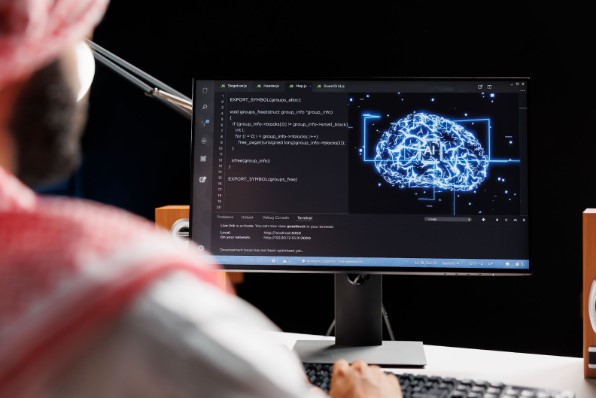intelligence (generative AI) has proven to be a powerful and promising tool in the area of cybersecurity. In this area, AI technologies are used to identify, prevent and combat various cyber threats, improving the protection of systems and data.
According to a study carried out by Gartner , AI Trust, Risk and Security Management was the main strategic technological trend pointed out for 2024.
Today, it is crucial that organizations and professionals involved in the area of cybersecurity are aware of the possibilities and challenges presented by generative AI, always seeking to update their knowledge and strategies to adapt to this constantly evolving scenario.
What is generative AI?
Generative AI is an Artificial Intelligence approach that seeks to create new content or ideas from existing data sets. This approach allows computers to automatically generate images, texts, music and other types of data without direct human intervention, providing innovative and efficient solutions.
What is the difference between AI and generative AI?
AI, or Artificial Intelligence, is a broad field that encompasses various techniques and approaches to create automated systems that can learn and reason like humans. Generative AI is a specific subarea, focused on automatically generating new content from existing data.
Some distinct characteristics of generative AI include:
- Data generation : Instead of just analyzing and interpreting information, generative AI seeks to create new content or ideas.
This involves using advanced machine learning and optimization techniques. - Creative process : Generative AI attempts to mimic the human creative process, allowing systems to “think” and “improvise” when generating new content.
This is particularly useful in areas such as art, design, advertising and scientific research.
Some examples of apps and tools that use generative AI include:
- Text generation : Software that automatically generates abstracts, articles, or other types of text from sets of data or specific instructions.
- Image generation : Programs that automatically create images, illustrations, or designs based on input parameters or data.
- Music generation : Systems that compose original melodies, harmonies, or rhythms using advanced machine learning algorithms and techniques.
With the advancement of AI technologies, generative AI is becoming increasingly sophisticated and efficient, opening up new opportunities and challenges in different sectors of society.
How do generative AI and cybersecurity relate?
Intelligence (AI) and cybersecurity are closely related, as both are based on analyzing patterns and detecting anomalies in large volumes of data. In this way, generative AI can be used as an effective tool in identifying and preventing threats to digital security. Some of the possible applications are:
- Intrusion detection : Generative AI can be trained to continuously analyze network traffic and identify suspicious activity.
Once a threat is identified, the tool can take preventative actions. - Malware analysis : Generative AI can be used to study the behavior of malicious software This way, it is possible to develop more efficient security solutions that neutralize threats.
- Data leak prevention : Generative AI can be programmed to monitor systems and identify unauthorized access attempts to sensitive information.
With this constant vigilance, cybersecurity is strengthened against potential theft and leaks. - Biometric authentication : Generative AI can be used to improve biometric authentication systems, such as facial or voice recognition, offering more robust and efficient security solutions.
What is the landscape of traditional cybersecurity systems today?
Currently, traditional cybersecurity systems face challenges in a scenario of increasing complexity and sophistication of cyber threats. The main approaches adopted include:
- Firewalls : These are barriers that filter network traffic between internal devices and the Internet.
They can be physical or virtual and prevent intrusion attempts by analyzing data traffic. - Antivirus : programs that identify and remove software , also known as malware .
They use signatures and heuristic analysis to detect known and unknown threats. - Intrusion detection and prevention systems (IDS/IPS) : monitor network traffic and take measures to block unwanted or malicious activity.
- Vulnerability management : continuous processes of identifying and correcting vulnerabilities in software and hardware. Includes the deployment of security patches and updates.
The technologies mentioned above are essential for protecting digital assets, but they have their limitations. For example, antiviruses are less effective against unknown and emerging threats, while firewalls can be bypassed through the use of VPNs and other evasion methods.
Organizations also face the need to manage a large volume of security information, such as event logs and alerts. Manually monitoring this data can be time-consuming and prone to human error. In this context, security information and event management (SIEM) systems play an important role, centralizing and correlating data to provide a more holistic view of the cybersecurity environment.
Traditional cybersecurity systems, therefore, are still an important part of protecting digital environments. However, it is increasingly important to adapt and integrate with new technologies, such as AI, to face emerging cyber threats and strengthen defenses against malicious attacks.
How Generative AI Strengthens Critical Data Defense
Synthetic data generation
Synthetic data generation is a technique in which Generative AI creates sets of non-real data, but with characteristics similar to the original data. This data can be used to improve the efficiency of defense systems and reduce the need to collect sensitive information. For example, they can be used to train machine learning models without exposing real, confidential data.
Anomaly detection
Generative AI can also be applied to detect anomalies in security systems. Through the use of deep learning algorithms, such as Convolutional Neural Networks (CNN) and Recurrent Neural Networks (RNN), it is possible to identify abnormal patterns in data and warn about possible security threats.
Generation of secure passwords
Another application is in generating secure passwords . Generative AI can create complex character combinations and sequences that are difficult for attackers to guess. By analyzing patterns and trends in stolen passwords, AI can suggest safer alternatives, increasing the resilience of access credentials.
Defense against adversary attacks
Generative AI can also be a powerful tool in defending against adversarial attacks spoofing and phishing attacks . By generating variations of content that simulate the techniques used by hackers, AI can help train defense and pattern recognition systems to be able to identify and block these types of attacks.
Differential privacy
The application of Generative AI in contexts involving differential privacy allows for the improvement of individual data protection. With this technique, it is possible to add noise to the collected data, preserving users' privacy and making it difficult to re-identify this information, while maintaining the usefulness of the data for analysis and research.
Secure content generation
Finally, Generative AI can be used to generate secure content , such as creating automated messages and emails to customers, without exposing sensitive information. AI can learn to create content that maintains the quality of information, without compromising the security and privacy of the users involved.
Privacy and ethics
Privacy and ethics in implementing generative AI in cybersecurity play a crucial role . It is essential to ensure that the data used to train models complies with data protection laws such as GDPR and LGPD . Furthermore, it is necessary to take into account the biases present in the data, avoiding the spread of inequalities and discrimination.
Interpretation and transparency
Interpretation and transparency are important points in implementing generative AI in cybersecurity. It is necessary that the models can be interpreted and explained by security experts, to ensure that the decisions made by the systems are fair and correct. This includes creating:
- Visualization techniques : Graphical representations of models and their results facilitate understanding and analysis.
- Metrics : To evaluate the performance and effectiveness of models in a clear and objective way.
Adversarial attacks
Adversarial attacks are a challenge in implementing generative AI in cybersecurity. adversarial examples that can mislead AI models and cause undesirable results. To deal with this threat, you must invest in:
- Research : In developing techniques and approaches to prevent or mitigate the effects of adversarial attacks.
- Monitoring : Detecting anomalies and suspicious activities that may be signs of an adversarial attack.
- Constant updates : To avoid obsolescence of models and ensure they are compliant with the latest threats.
Regulation and compliance
Regulation and compliance are key aspects of implementing generative AI in cybersecurity. Organizations and companies must ensure that their AI systems comply with applicable regulatory standards and laws ISO/IEC 27001 or PCI DSS . This involves:
- Implement data governance policies and processes.
- Establish auditing and access control mechanisms for data and AI systems.
- Ensure accountability of developers and professionals involved in creating and maintaining models.
Protect your data with Skyone
Skyone is a leading cybersecurity solutions company that already uses artificial intelligence (AI) and machine learning to protect companies' data and infrastructure, offering integrated solutions that include threat detection, rapid incident response and continuous security monitoring . systems.
Through our platform, we are able to offer services such as:
- Threat analysis : that maintain the security and integrity of your business operations;
- Security Operations Center (SOC) : which protects your company from attacks with a 24×7 operation made up of several information security specialists, who monitor events, threats, vulnerabilities and work to mitigate, remediate and contain attacks or malicious behavior ;
- Endpoint Detection and Response (EDR) : identifies any anomalous behavior at the endpoint: our EDR product collects telemetry that provides visibility into the actions, processes and connections carried out at the endpoint, processing this information and contextualizing it within a timeline of events;
- Web Application Firewall (WAF) : Enhances the security of your web applications with our WAF, which monitors incoming and outgoing traffic, filtering malicious requests that may attempt to exploit vulnerabilities.
- Pentest : through this, our experts proactively check whether there are loopholes in accessing your confidential information, the possibility of denial of services, the hijacking of data for the purpose of demanding ransom and much more.
In addition to these benefits, Skyone is concerned with offering training and awareness to employees of client companies, ensuring that everyone is prepared to identify and deal with potential risks and threats. This approach helps to minimize risks and reinforce the security culture throughout the corporate environment.
Skyone uses these techniques in innovative and effective ways to protect its customers and ensure business continuity in an increasingly complex and challenging digital environment.
Conclusion
AI applied to cybersecurity has enormous potential in combating digital threats, offering innovative and efficient solutions. Using advanced machine learning models, this technology goes through a continuous process of improvement in identifying patterns and preventing attacks.
With the exponential growth of the digital world and the amount of data available, generative AI is an essential tool for protecting information and infrastructure. The constant advancement of this technology will provide more robust cybersecurity, capable of facing new threats and challenges posed by digital evolution.




